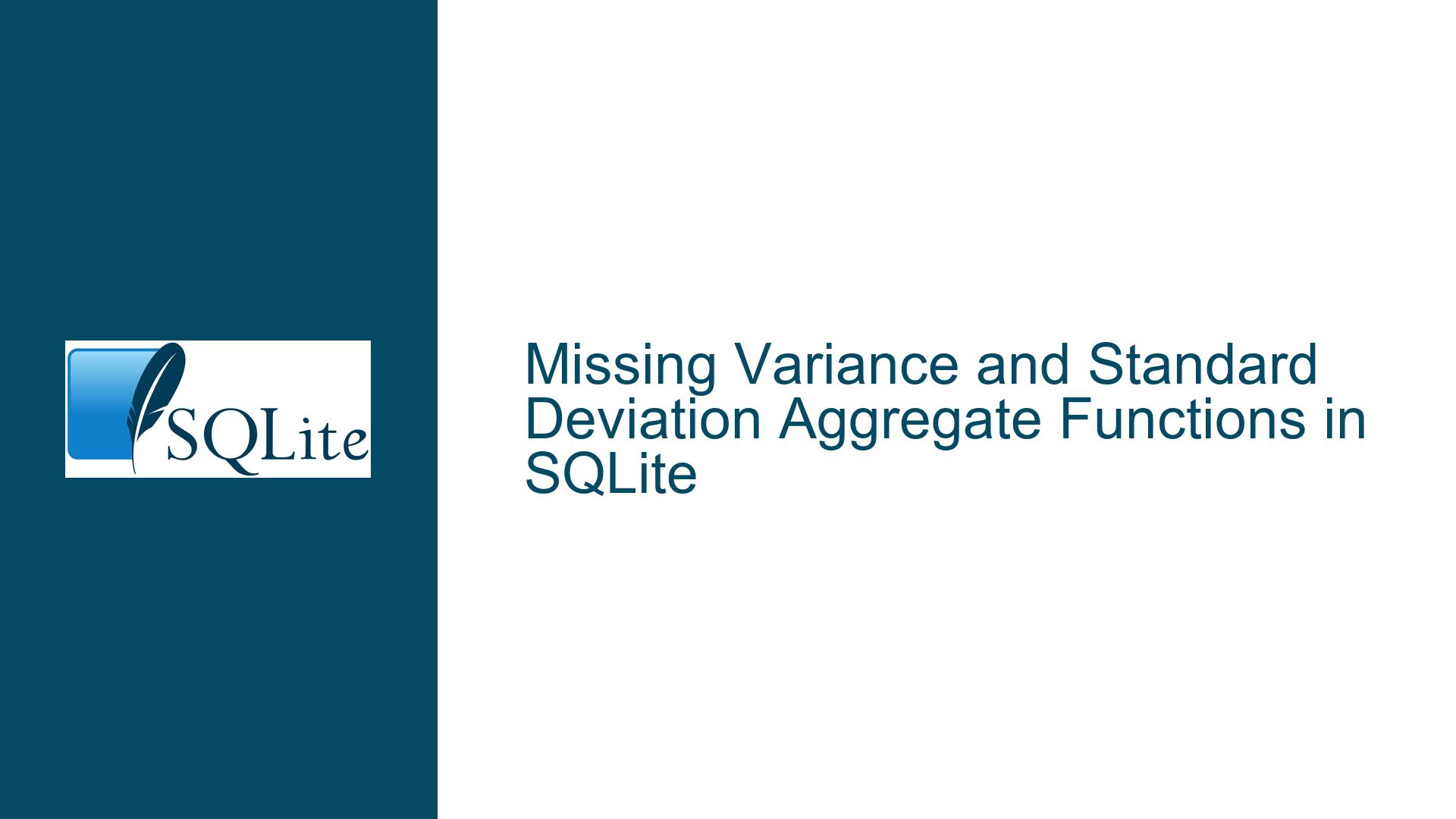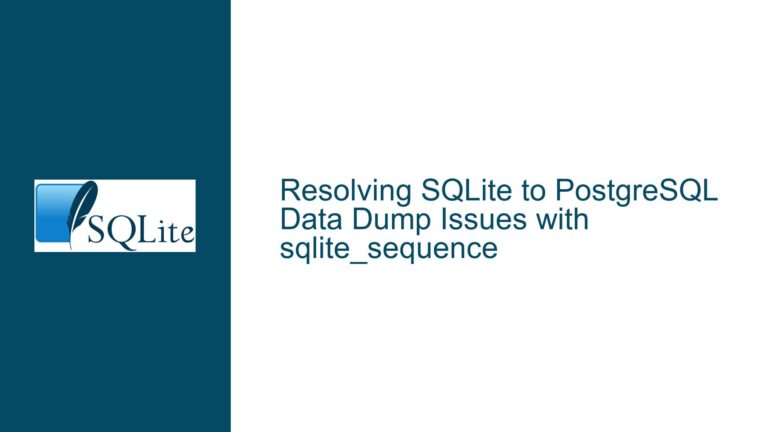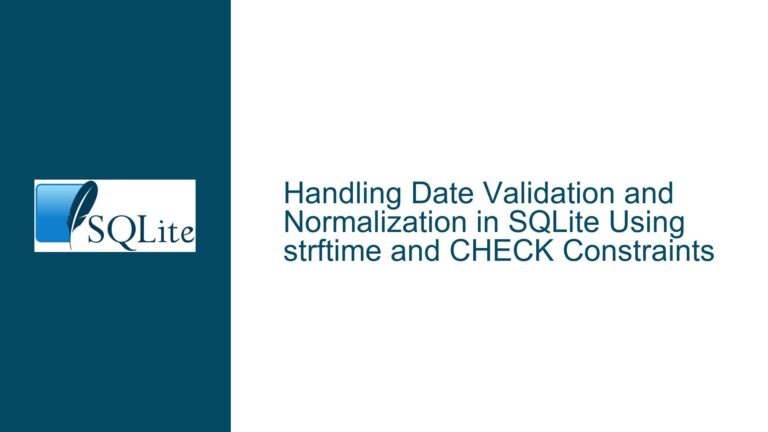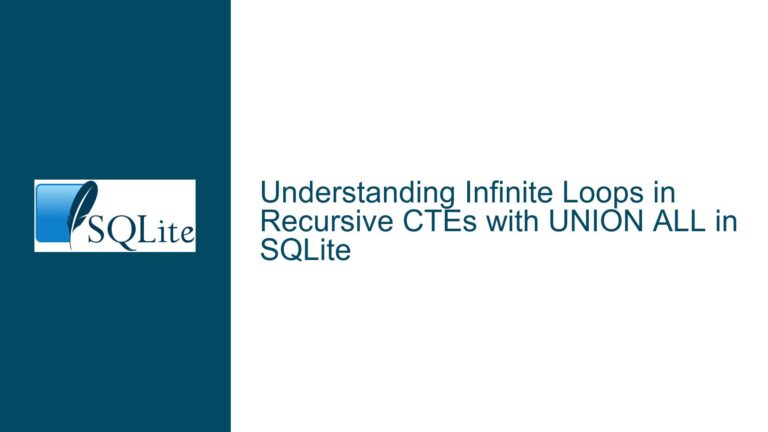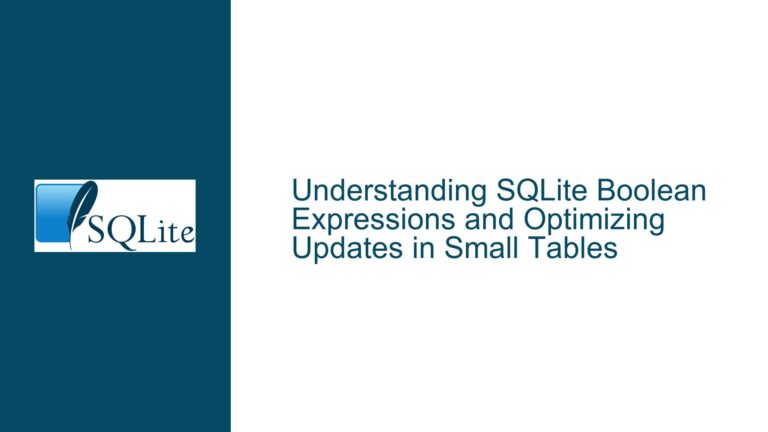Missing Variance and Standard Deviation Aggregate Functions in SQLite
Variance and Standard Deviation Calculations in SQLite
SQLite, being a lightweight and embedded database engine, is designed with simplicity and minimalism in mind. While it provides a robust set of built-in aggregate functions such as COUNT, SUM, AVG, MIN, and MAX, it notably lacks built-in support for statistical functions like variance and standard deviation. These functions are essential for many data analysis tasks, particularly in fields such as finance, engineering, and scientific research. Variance and standard deviation are measures of dispersion that indicate how much a set of values deviates from the mean. Variance is the average of the squared differences from the mean, while standard deviation is the square root of the variance.
The absence of these functions in SQLite can be attributed to the database’s design philosophy, which prioritizes simplicity and small footprint over comprehensive statistical functionality. SQLite is often used in environments where resource constraints are a concern, such as embedded systems, mobile applications, and small-scale web applications. Adding more complex aggregate functions like variance and standard deviation would increase the size of the SQLite library and potentially impact its performance in resource-constrained environments.
However, the lack of built-in support for these functions does not mean that they cannot be implemented in SQLite. SQLite’s extensibility allows developers to define custom aggregate functions using the create_aggregate function. This function enables the creation of user-defined aggregate functions that can perform complex calculations, including variance and standard deviation. The implementation of these functions can be done using algorithms like Welford’s method, which is numerically stable and efficient for calculating variance and standard deviation incrementally.
Welford’s method is particularly well-suited for SQLite because it allows for the calculation of variance and standard deviation in a single pass through the data, which is ideal for aggregate functions that process rows one at a time. The method works by maintaining running totals of the mean and the sum of squared differences, which are updated with each new value. This approach avoids the need to store all the values in memory, making it memory-efficient and suitable for large datasets.
Despite the availability of user-defined aggregate functions, the process of implementing and integrating these functions into SQLite can be cumbersome. It requires a deep understanding of SQLite’s C API and the programming language being used to interface with SQLite. Additionally, the implementation must be thoroughly tested and debugged to ensure accuracy and reliability. This can be a significant barrier for developers who are not familiar with SQLite’s internals or who are working in environments where access to the create_aggregate function is restricted.
Challenges in Implementing Variance and Standard Deviation in SQLite
The primary challenge in implementing variance and standard deviation in SQLite lies in the database’s lack of built-in support for these functions. This forces developers to either implement custom aggregate functions or calculate these metrics outside of SQLite. Both approaches have their own set of challenges and limitations.
Implementing custom aggregate functions requires a solid understanding of SQLite’s C API and the programming language being used to interface with SQLite. The create_aggregate function must be used to define the aggregate function, which involves writing C code to handle the aggregation logic. This code must be carefully written to ensure that it correctly calculates the variance and standard deviation using an algorithm like Welford’s method. The implementation must also handle edge cases, such as empty datasets or datasets with only one value, to avoid division by zero errors or incorrect results.
Another challenge is the integration of custom aggregate functions into the application code. This typically involves compiling the C code into a shared library or embedding it directly into the application. The process can be complex and error-prone, particularly for developers who are not experienced with SQLite’s C API or the build tools required to compile and link the code. Additionally, the custom aggregate function must be registered with SQLite before it can be used in queries, which adds another layer of complexity.
Calculating variance and standard deviation outside of SQLite is another option, but it comes with its own set of challenges. This approach typically involves retrieving the data from SQLite and performing the calculations in the application code. While this avoids the need to implement custom aggregate functions, it can be inefficient, particularly for large datasets. Transferring large amounts of data from SQLite to the application can be slow and resource-intensive, and the calculations must be performed in memory, which can be a limitation for very large datasets.
Furthermore, calculating variance and standard deviation outside of SQLite can lead to inconsistencies in the data analysis process. If the calculations are performed in multiple places within the application, there is a risk of introducing errors or inconsistencies due to differences in the implementation of the algorithms. This can make it difficult to ensure the accuracy and reliability of the results.
Implementing Custom Aggregate Functions for Variance and Standard Deviation
To address the challenges of implementing variance and standard deviation in SQLite, developers can create custom aggregate functions using SQLite’s extensibility features. The process involves defining the aggregate function using the create_aggregate function and implementing the aggregation logic in C code. The following steps outline the process of implementing a custom aggregate function for variance and standard deviation using Welford’s method.
The first step is to define the aggregate function in SQLite. This is done using the create_aggregate function, which takes the name of the aggregate function, the number of arguments it accepts, and pointers to the functions that implement the aggregation logic. The aggregation logic is typically implemented in three functions: a step function, a final function, and an optional value function. The step function is called for each row in the result set and updates the running totals for the mean and the sum of squared differences. The final function is called after all rows have been processed and calculates the final variance and standard deviation values. The value function is optional and can be used to return intermediate results during the aggregation process.
The next step is to implement the aggregation logic using Welford’s method. Welford’s method is an incremental algorithm that calculates the mean and variance in a single pass through the data. The algorithm works by maintaining running totals of the mean and the sum of squared differences, which are updated with each new value. The mean is updated using the formula:
[ \text{newMean} = \text{oldMean} + \frac{(x – \text{oldMean})}{N} ]
where ( x ) is the new value, ( \text{oldMean} ) is the current mean, and ( N ) is the number of values processed so far. The sum of squared differences is updated using the formula:
[ \text{newSumSq} = \text{oldSumSq} + (x – \text{oldMean}) \times (x – \text{newMean}) ]
where ( \text{oldSumSq} ) is the current sum of squared differences. The variance is then calculated as:
[ \text{variance} = \frac{\text{sumSq}}{N} ]
and the standard deviation is the square root of the variance.
The implementation of the step function involves updating the running totals for the mean and the sum of squared differences using the formulas above. The final function calculates the variance and standard deviation using the final values of the running totals. The value function, if implemented, can return intermediate results, such as the current mean or variance, during the aggregation process.
Once the custom aggregate function is implemented, it must be compiled into a shared library or embedded directly into the application. The shared library must be loaded into SQLite using the load_extension function, and the custom aggregate function must be registered with SQLite using the create_aggregate function. The function can then be used in SQL queries like any other aggregate function.
The following table summarizes the steps involved in implementing a custom aggregate function for variance and standard deviation in SQLite:
| Step | Description |
|---|---|
| 1 | Define the aggregate function using create_aggregate. |
| 2 | Implement the step function to update the running totals for the mean and sum of squared differences. |
| 3 | Implement the final function to calculate the variance and standard deviation. |
| 4 | Optionally implement the value function to return intermediate results. |
| 5 | Compile the C code into a shared library or embed it directly into the application. |
| 6 | Load the shared library into SQLite using load_extension. |
| 7 | Register the custom aggregate function with SQLite using create_aggregate. |
| 8 | Use the custom aggregate function in SQL queries. |
In conclusion, while SQLite does not provide built-in support for variance and standard deviation, these functions can be implemented using custom aggregate functions. The process involves defining the aggregate function, implementing the aggregation logic using Welford’s method, and integrating the function into the application. Although this approach requires a deep understanding of SQLite’s C API and the programming language being used, it provides a powerful and flexible way to extend SQLite’s functionality to meet the needs of complex data analysis tasks.
